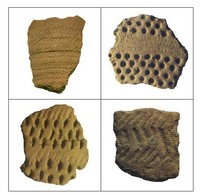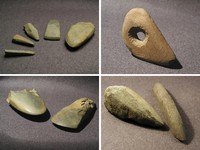Investigations of Stone Age settlements
 @kizhi
@kizhi


The archaeological expedition of the Kizhi museum (the heads of the expedition are I. V. Melnikov and K. E. Gherman) has been conducting explorations and excavations on the territory of the southern Zaonezhie (Medvezhegorsk district) since 1995. As a result, more than 50 archaeological monuments have been discovered. They are remains of ancient settlements and are dated from the Stone Age – the early Metal Age. All of them are located in the southern part of the Zaonezhie peninsula. The most part of them (Vozhmarikha 1-27) is situated north of the Vozhmarikha Bay, others (Vertilovo 1-7, Lelikovo 1-2, Juzhny Oleniy Ostrov 1-2, Severny Oleniy Ostrov 1-2, Sennaya Guba 1-2, Vorob’i 2-3, Kalgov 1, Bukolnikov 1, Kerostrov 3) are located on the shore of the Muhdguba Bay, in the area of small internal lake Kopanets, on the shore of the Solomennaya Guba Bay, on northern tip of the Island of Bolshoy Lelikovsky, on Juzhny Oleniy island, Severny Oleniy island and on the island of Bolshoy Klimenetsky. The Vozhmarikha 1-27 settlements form a compact group and are located north of the modern shoreline of the Vozhmarikha Bay on the area of about 2 x 0, 3 km. All the sites are situated on forested sandy terraces that indicate the ancient shoreline of Lake Onega. Their altitude above the level of Lake Onega varies from 2-3 to 10-11 m. Their current remoteness from the shore is from 30 to 1500 m.
Obviously, their location in ancient times was defined by the location of the shoreline of the Vozhmarikha Bay, which, according to the available paleogeographic data, had different outlines in the Atlantic and Subboreal periods of the Holocene. It jutted out deeply into the shore and was connected with the lake by a narrow strait protected by islands from wind. At present, this part of the bay represents a swamp.
Excavations of settlements of different epochs are conducted every year. The rest are subjected to exploration with opening of a cultural layer on areas from 1 to 16 m2. The thickness of a cultural layer of the most open sites is from 20 to 50 cm. The layer yields rich cultural remains. As a rule, this is reddish-brown sand that lies under a thin layer of turf and podsol. Since the most sites have just one prospecting shaft put down, the area of sites has been determined presumably, on the basis of topographic features and a number of dug out hollows (where available). According to preliminary data it ranges from 500 to 6000 m2, predominantly about 1000-2000 m2. All the known types of the Neolithic – Eneolithic ceramics in Obonezhie are represented in different settlements: sperrings (Vertilovo 3, 7; Vorob’i 2), pit-comb (Vozhmarikha 2, 4, 15; Lelikovo 1, 2; Sennaya Guba 2, Severny Oleniy Ostrov 1, 2; Vorob’i 2; Bukolnikov 1), comb-pit (Vozhmarikha 1, 7, 20, 21; Kalgov 1), rhombus-and-pit (Vertilovo 2), asbestos and porous (Vozhmarikha 18, 19). The highest altitude of these settlements is 5-6 m above the current level of Lake Onega. Sites that are located higher in altitude do not contain any ceramics. It should be noted that some round and oval shaped hollows of different sizes and an average depth of 0, 5 m have been detected on the surface of 14 settlements (Vozhmarikha 1-9, 13, 17, 18; Vertilovo 2, 3). They are possibly the remains of dug out structures. This assumption was confirmed during the excavation of the hollows in the Vozhmarikha 1, 2, 3, 4 settlements.
Investigations of the Oleneostrovskiy burial ground and the Severny Oleniy Ostrov 1-2 settlements have been carried out together with archeologists and anthropologists of the Institute for the History of Material Culture of Russian Academy of Sciences, St. Petersburg State University, the Institute of Linguistics, History and Literature of the Karelian Research Centre and the Museum of Anthropology and Ethnography of the Russian Academy of Sciences since 2005. The investigations were supported in 2006 by the two-year grant (2006-2007) of the Russian Foundation for Basic Research № 06-06-88017-к “The origin and formation processes of the Nothern Europe’s population (anthropological composition, human ecology, historical and cultural development)”. In the course of the excavation some interesting materials have been obtained that shed light on the unique Oleneostrovskiy burial ground.
The archaeological expedition of the Kizhi museum (the heads of the expedition are I. V. Melnikov and K. E. Gherman) has been conducting explorations and excavations on the territory of the southern Zaonezhie (Medvezhegorsk district) since 1995. As a result, more than 50 archaeological monuments have been discovered. They are remains of ancient settlements and are dated from the Stone Age – the early Metal Age. All of them are located in the southern part of the Zaonezhie peninsula. The most part of them (Vozhmarikha 1-27) is situated north of the Vozhmarikha Bay, others (Vertilovo 1-7, Lelikovo 1-2, Juzhny Oleniy Ostrov 1-2, Severny Oleniy Ostrov 1-2, Sennaya Guba 1-2, Vorob’i 2-3, Kalgov 1, Bukolnikov 1, Kerostrov 3) are located on the shore of the Muhdguba Bay, in the area of small internal lake Kopanets, on the shore of the Solomennaya Guba Bay, on northern tip of the Island of Bolshoy Lelikovsky, on Juzhny Oleniy island, Severny Oleniy island and on the island of Bolshoy Klimenetsky. The Vozhmarikha 1-27 settlements form a compact group and are located north of the modern shoreline of the Vozhmarikha Bay on the area of about 2 x 0, 3 km. All the sites are situated on forested sandy terraces that indicate the ancient shoreline of Lake Onega. Their altitude above the level of Lake Onega varies from 2-3 to 10-11 m. Their current remoteness from the shore is from 30 to 1500 m. Obviously, their location in ancient times was defined by the location of the shoreline of the Vozhmarikha Bay, which, according to the available paleogeographic data, had different outlines in the Atlantic and Subboreal periods of the Holocene. It jutted out deeply into the shore and was connected with the lake by a narrow strait protected by islands from wind. At present, this part of the bay represents a swamp.
Excavations of settlements of different epochs are conducted every year. The rest are subjected to exploration with opening of a cultural layer on areas from 1 to 16 m2. The thickness of a cultural layer of the most open sites is from 20 to 50 cm. The layer yields rich cultural remains. As a rule, this is reddish-brown sand that lies under a thin layer of turf and podsol. Since the most sites have just one prospecting shaft put down, the area of sites has been determined presumably, on the basis of topographic features and a number of dug out hollows (where available). According to preliminary data it ranges from 500 to 6000 m2, predominantly about 1000-2000 m2. All the known types of the Neolithic – Eneolithic ceramics in Obonezhie are represented in different settlements: sperrings (Vertilovo 3, 7; Vorob’i 2), pit-comb (Vozhmarikha 2, 4, 15; Lelikovo 1, 2; Sennaya Guba 2, Severny Oleniy Ostrov 1, 2; Vorob’i 2; Bukolnikov 1), comb-pit (Vozhmarikha 1, 7, 20, 21; Kalgov 1), rhombus-and-pit (Vertilovo 2), asbestos and porous (Vozhmarikha 18, 19). The highest altitude of these settlements is 5-6 m above the current level of Lake Onega. Sites that are located higher in altitude do not contain any ceramics. It should be noted that some round and oval shaped hollows of different sizes and an average depth of 0, 5 m have been detected on the surface of 14 settlements (Vozhmarikha 1-9, 13, 17, 18; Vertilovo 2, 3). They are possibly the remains of dug out structures. This assumption was confirmed during the excavation of the hollows in the Vozhmarikha 1, 2, 3, 4 settlements.
Investigations of the Oleneostrovskiy burial ground and the Severny Oleniy Ostrov 1-2 settlements have been carried out together with archeologists and anthropologists of the Institute for the History of Material Culture of Russian Academy of Sciences, St. Petersburg State University, the Institute of Linguistics, History and Literature of the Karelian Research Centre and the Museum of Anthropology and Ethnography of the Russian Academy of Sciences since 2005. The investigations were supported in 2006 by the two-year grant (2006-2007) of the Russian Foundation for Basic Research № 06-06-88017-к “The origin and formation processes of the Nothern Europe’s population (anthropological composition, human ecology, historical and cultural development)”. In the course of the excavation some interesting materials have been obtained that shed light on the unique Oleneostrovskiy burial ground.
